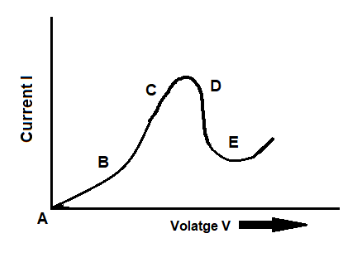
Graph showing the variation of current versus voltage for a material Ga. As is shown in the figure, identify the region of:
(i) Negative resistance
(ii) Where Ohm’s law is obeyed.


Answer
488.1k+ views
Hint:To find the region where Ohm’s law is obeyed, we should know the limitations of ohm’s law and the slope must be constant. To find the region where there is negative resistance, we have to observe the slopes of the graph at every region.
Complete step by step answer:
We are given a graph showing the variation of current versus voltage for a material Ga.
We have to find the negative resistance and the region where the Ohm’s law is obeyed.
According to Ohm’s law, the current passing through a conductor is directly proportional to voltage applied across it.
Thus
Here we can see that for Ohm’s law to be valid, the slope of the I versus V curve should be constant and positive. The BC region in the graph is a straight line and the slope of the graph at every point in the BC region is the same and positive. Hence region BC obeys ohm’s law.
The slope of I versus V curve is negative in the region DE as the curve is descending downwards. Hence the resistance is negative in the region DE.
Note:Conductors which obey Ohm’s law have a constant resistance when the voltage is varied across them or the current through them is increased. These conductors are called Ohmic conductors. When the curve is descending then the slope is negative and when the curve is ascending the slope is positive. Be careful with this.
Complete step by step answer:
We are given a graph showing the variation of current versus voltage for a material Ga.
We have to find the negative resistance and the region where the Ohm’s law is obeyed.
According to Ohm’s law, the current passing through a conductor is directly proportional to voltage applied across it.
Thus
Here we can see that for Ohm’s law to be valid, the slope of the I versus V curve should be constant and positive. The BC region in the graph is a straight line and the slope of the graph at every point in the BC region is the same and positive. Hence region BC obeys ohm’s law.
The slope of I versus V curve is negative in the region DE as the curve is descending downwards. Hence the resistance is negative in the region DE.
Note:Conductors which obey Ohm’s law have a constant resistance when the voltage is varied across them or the current through them is increased. These conductors are called Ohmic conductors. When the curve is descending then the slope is negative and when the curve is ascending the slope is positive. Be careful with this.
Latest Vedantu courses for you
Grade 10 | MAHARASHTRABOARD | SCHOOL | English
Vedantu 10 Maharashtra Pro Lite (2025-26)
School Full course for MAHARASHTRABOARD students
₹31,500 per year
Recently Updated Pages
Express the following as a fraction and simplify a class 7 maths CBSE

The length and width of a rectangle are in ratio of class 7 maths CBSE

The ratio of the income to the expenditure of a family class 7 maths CBSE

How do you write 025 million in scientific notatio class 7 maths CBSE

How do you convert 295 meters per second to kilometers class 7 maths CBSE

Write the following in Roman numerals 25819 class 7 maths CBSE

Trending doubts
Give 10 examples of unisexual and bisexual flowers

Draw a labelled sketch of the human eye class 12 physics CBSE

Differentiate between homogeneous and heterogeneous class 12 chemistry CBSE

Differentiate between insitu conservation and exsitu class 12 biology CBSE

What are the major means of transport Explain each class 12 social science CBSE

Franz thinks Will they make them sing in German even class 12 english CBSE




